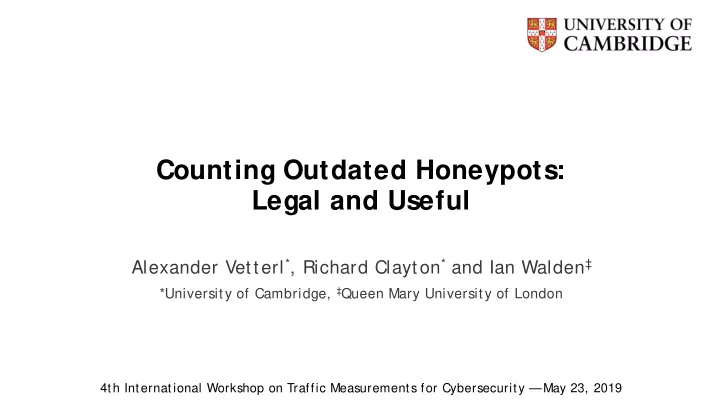

Counting Outdated Honeypots: Legal and Useful Alexander Vetterl * , Richard Clayton * and Ian Walden ‡ *University of Cambridge, ‡ Queen Mary University of London 4th International Workshop on Traffic Measurements for Cybersecurity —May 23, 2019
Introduction Honeypot: A resource whose value is being attacked or compromised Cowrie – commands implemented — Honeypots have been focused for years on the monitoring of human activity — Adversaries attempt to distinguish honeypots by executing commands — Honeypots continuously fix commands to be “ more like bash” 3
How we currently build SSH honeypots 1. Find a library that implements the desired protocol (e.g. TwistedConch for S S H) 2. Write the Python program to be “ j ust like bash” 3. Fix identity strings, error messages etc. to be “ j ust like OpenS S H” RFCs OpenS S H TwistedConch sshd Cowrie bash Problem: There are lot of subtle differences between TwistedConch and OpenS S H… 4
Fingerprinting honeypots at internet scale We send probes to various different implementations — S S H honeypots (Cowrie/ Kippo) — OpenS S H, TwistedConch We find ‘ the’ probe that results in the most distinctive response across all implementations and perform Internet wide scans Login to get more details, but… Alexander Vetterl and Richard Clayton, “Bitter Harvest: Systematically Fingerprinting Low- and Medium-interaction 5 Honeypots at Internet Scale,” in 12 th USENIX Workshop on Offensive Technologies (WOOT ‘18). USENIX Association, Baltimore, USA
Paper was rejected due to ethical concerns “ This paper was rej ected due to ethical concerns. [… ] It was pointed out that these attempts are likely a violation of US law , especially the Computer Fraud and Abuse Act which prohibits accessing a computer without authorization. The PC recommends to consult with a lawyer before trying to publish this paper a different venue.” S ummary of the PC discussion 6
Uniformed legislation for unauthorised access Convention on Cybercrime (“Budapest Convention”) — S tates must have laws that forbit access ‘ without right’ — Ratified by 62 states EU Directive 2013/40/EU Article 3 — ‘ Member states [… ] shall ensure that, when committed intentionally, the access without right , [… ] is punishable as a criminal offence where committed by infringing a security measure, at least for cases which are not minor .’ 7
Legislation in the UK and USA UK: Computer Misuse Act 1990 Access of any kind by any person to any program Factors to consider or data held in a computer is unauthorised if – a) [… ] — No consent t o access [by him] of t he ‘ kind b) he does not have consent to access by him of in quest ion’ the kind in question to the program or data. — Overcome some form of securit y mechanism USA: Fraud and Abuse Act 1986 — Offences which are not minor ‘ Whoever [… ] intentionally accesses a computer without authorization [… ] and thereby obtains [… ] information from any protected computer.’ 8
Legislation in the context of honeypots In general much authorisation is implicit — Devices and services intentionally connected to the Internet — Web servers/ ftp servers with the username ‘ anonymous’ and email address as password Our access was not unauthorised because the controller of the honeypot has – — intentionally made available a (vulnerable) system and — implicitly permits the access of the ‘ kind of question’ 9
Ethical considerations — We followed our institution’s ethical research policy — We used the exclusion list maintained by DNS -OARC — We notified all local CERTs of our scans/ actions — We respected requests to be excluded from further scanning — We started and ended every S S H session with an explanation — We notified the relevant honeypot and library developers of our findings 10
Results –Authentication configuration (1/2) — We used the username root and initially 6 passwords, later 500 passwords — We managed to successfully log in to about 70% of the honeypots 11
Results –Authentication configuration (2/2) — Using 500 passwords is not better than 6 passwords — About 11% of honeypot operators do not allow logins 12
Revision history for command selection — We looked for commands in the revision history (uname -a, tftp) Cowrie < 2016-11-02 Cowrie ≥ 2016 -11-02 13
Results – Counting outdated honeypots (1/2) — High market share for Kippo, which had last been updated years earlier — Only ~25% of honeypots were up-to-date 14
Results – Counting outdated honeypots (2/2) — The number of S S H honeypots is slightly declining (-14.6% ) — Kippo is slowly being replaced by Cowrie 15
Results – Set-up options SSH Version strings — 61 different version strings — 72% use the default – SSH-2.0-OpenSSH_6.0p1 Debian-4+deb7u2 Hostname ( uname uname –a ) — 3.3% use the default - svr04 debnfwmgmt-02 is used for 296 honeypots (14.6% ) — — This is the default hostname for Cowrie when it is used in T-Pot — T-Pot is a popular docker container and combines 16 honeypots — T-Pot has a significant market share 16
Conclusion Many honeypots are outdated and not looked after — Update your honeypots! Honeypot operators do not change default configurations — Usernames/ passwords, hostnames, S S H version strings etc. Our access to honeypots was not unauthorized — Detailed legal analysis to enable more research in this area — Lessons learned: Provide not only an ethical j ustification, but also some legal analysis 17
Q & A Alexander Vetterl alexander.vetterl@cl.cam.ac.uk 18
Recommend
More recommend